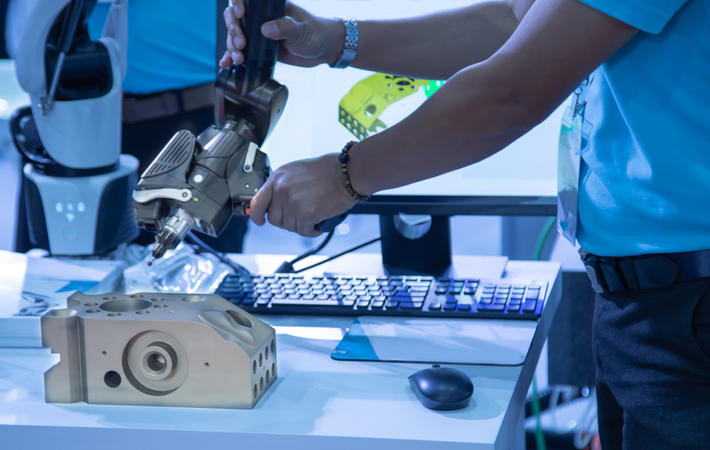
3D scanning in the foundry: the quality control revolution
The foundry industry is undergoing a seismic transformation, driven by the increasing complexity of cast components, the growing demand for precision and the need to implement increasingly rapid and effective quality control processes in die casting. At the heart of this technological evolution is 3D scanning in the foundry, a versatile tool that offers unprecedented capabilities for quality assurance (QA) and quality control (QC).
Traditional measurement techniques, such as calipers, comparators and coordinate measuring machines (CMM), often fail to meet the needs of the modern industry. These methods are time-consuming, less accurate and inadequate for complex geometries. In contrast, portable laser scanners and advanced 3D metrology software for the foundry provide fast, comprehensive and highly precise inspections. From mold creation to final product verification, 3D scanning integrates seamlessly into the Product Lifecycle Management (PLM) process.
Traditional measurement techniques, such as calipers, comparators and coordinate measuring machines (CMMs), often fail to meet the demands of today’s industry. These methods are time-consuming, less accurate and inadequate for complex geometries. In contrast, portable laser scanners and advanced 3D metrology software for foundries provide fast, comprehensive and highly accurate inspections. From mold creation to final product verification, 3D scanning integrates seamlessly into the Product Lifecycle Management (PLM) process.
Revolutionary advantages of 3D scanning in foundries over traditional methods
A significant advantage of 3D scanning technology is the ability to perform complete surface assessments with intuitive color comparisons. This feature allows manufacturers to identify deviations and make informed decisions quickly, revolutionizing the approach to quality control in die casting. In addition, the technology dramatically simplifies data interpretation and promotes more effective communication between different departments, ensuring a cohesive and integrated workflow.
Industry experience clearly demonstrates the benefits foundries around the world are seeing. Companies are using 3D scanning for first article inspection, tool validation, and root cause analysis, optimizing production processes and significantly reducing non-conformances.
Practical Applications and Case Studies in the Foundry Industry
In addition to optimizing quality control, 3D scanning technology in foundries is completely redefining the way foundries approach the various stages of production and troubleshooting. Its versatility allows for seamless integration into different areas of the production process, addressing challenges that traditional methods cannot effectively solve.
Optimizing Production Processes with On-Site Scanning
A case in point is a foundry specializing in automotive manufacturing that makes structural and powertrain components. In the past, the company relied on fixed scanning systems in centralized measurement rooms, causing significant delays that interrupted production. The integration of portable scanners and advanced inspection software directly into production completely revolutionized quality control in die casting.
This setup allowed operators to perform on-site inspections, dramatically reducing response times and improving accuracy. Tasks such as analyzing repaired molds and comparing components to CAD models became faster and more reliable, reducing scrap, lowering operating costs, and significantly improving the quality of the final parts.
Simplifying Reverse Engineering and Accelerating Inspections
Another notable example comes from the industrial pump industry, where a foundry faced challenges with conventional optical systems that required extensive preparation, such as spraying components. Adopting advanced 3D scanning technologies dramatically simplified the process of capturing complex geometries and surface details.
The technology enabled the reverse engineering team to create oil chamber casings and quickly and accurately compare sand cores to CAD models. This technological shift allowed the company to meet higher quality standards, improve operational flows, and focus on delivering superior products to its customers.
Modernizing Dimensional Inspection with Micrometer Accuracy
A foundry specializing in structural castings adopted next-generation 3D scanning technologies to modernize their dimensional control processes. The scanners’ accuracy of 75 μm offered a significant advantage over traditional methods, enabling fast and detailed inspections directly on the workbench.
With this cutting-edge technology, the foundry dramatically improved accuracy and efficiency, reducing production delays. This advanced 3D foundry metrology solution allowed the company to maintain its commitment to high-quality standards and achieve reliable results even for highly complex castings.
Root Cause Analysis and Rapid Troubleshooting
3D scanners have become indispensable for root cause analysis, enabling manufacturers to diagnose issues such as unexpected vibrations or premature failures with unprecedented speed and accuracy. Their versatility enables measurements in harsh environments, eliminating the need to transport components to controlled labs. By integrating 3D scanning directly into production workflows, foundries achieve faster troubleshooting and significantly more efficient operations.
Advanced technologies also enable precise inspection of welded components, assessing alignments, actual positions, and critical features such as joints and brackets. These tools detect deviations early, reducing rework and delays, enabling on-site inspections for greater operational efficiency. Additionally, digital twins created with scanners improve predictive maintenance, monitor component wear, and continuously optimize manufacturing processes.
The Future of Manufacturing: Continuous Integration and Innovation
Investing in 3D scanning technology for foundries is not just about staying competitive, it is about truly redefining the future of manufacturing. The reliability, accuracy and portability of modern solutions make them indispensable tools to address contemporary challenges and drive innovation in the industry.
The future of foundry manufacturing is inextricably linked to the continued adoption of 3D scanning technologies. As demonstrated by the applications and successes seen in the industry, this technology is revolutionizing quality control in die casting, accelerating production cycles and providing manufacturers with a more precise and reliable way to manage their processes. As the industry evolves, 3D metrology for foundries will play an increasingly critical role in shaping the future of the manufacturing industry.
Source: In Fonderia – Il magazine dell’industria fusoria italiana


